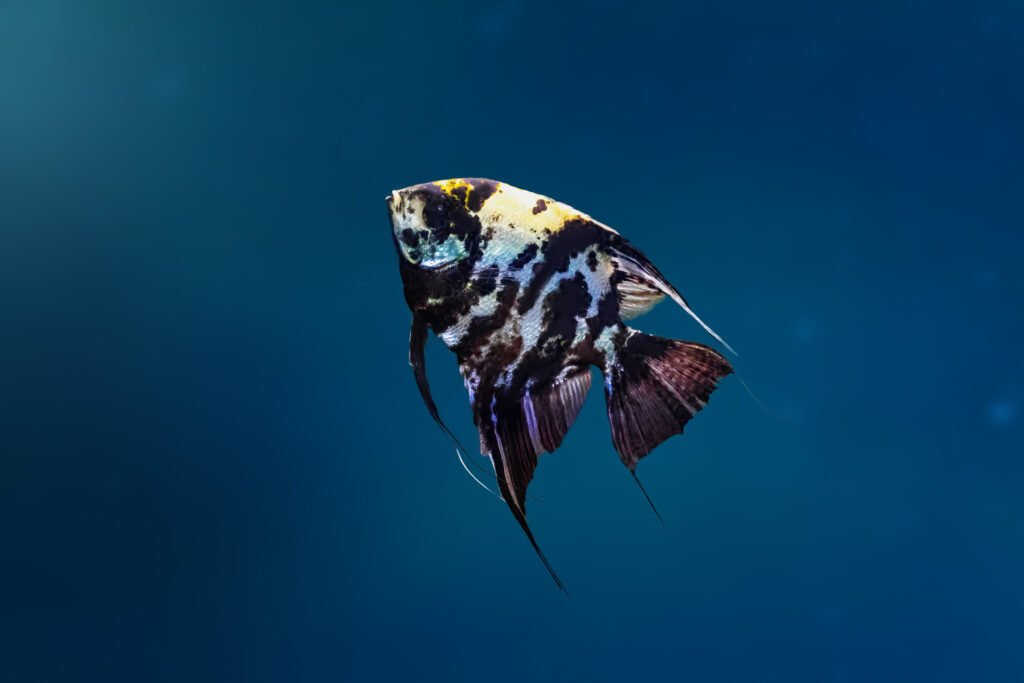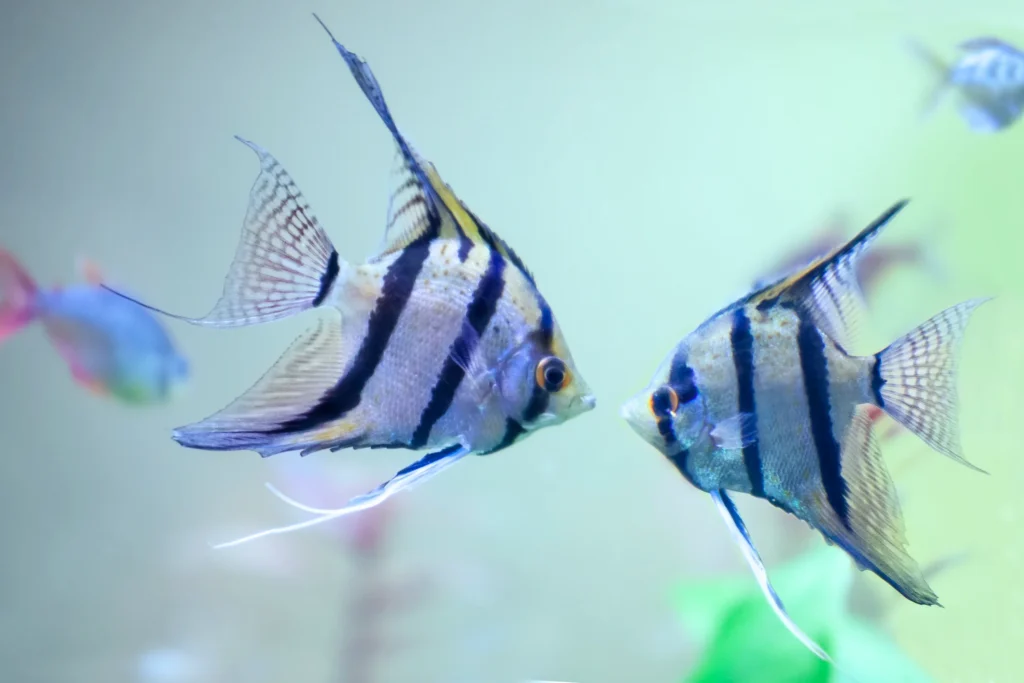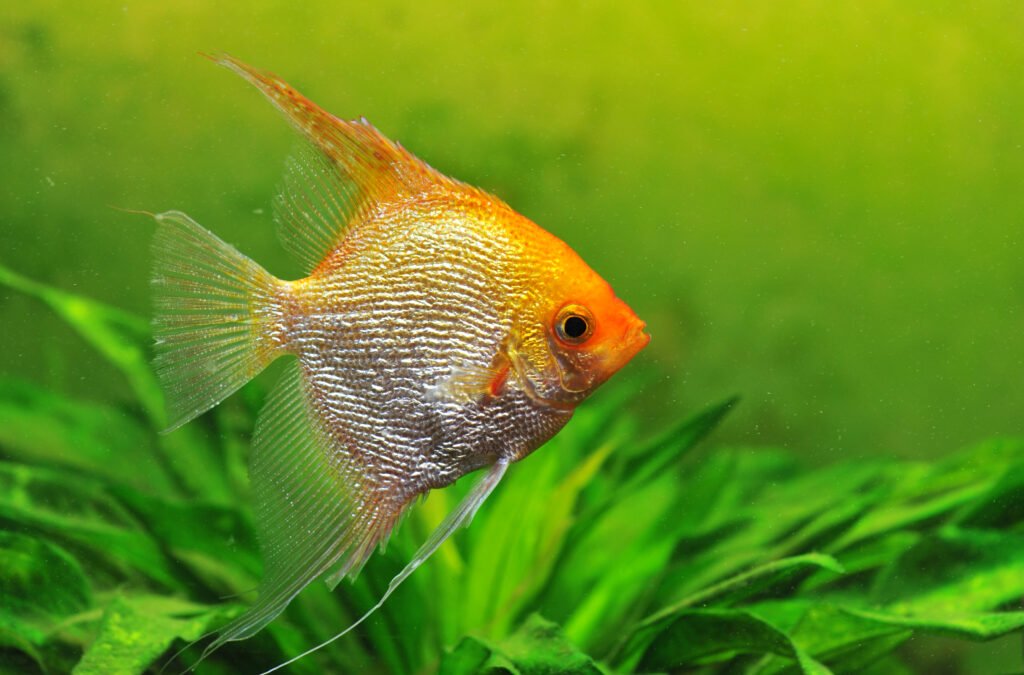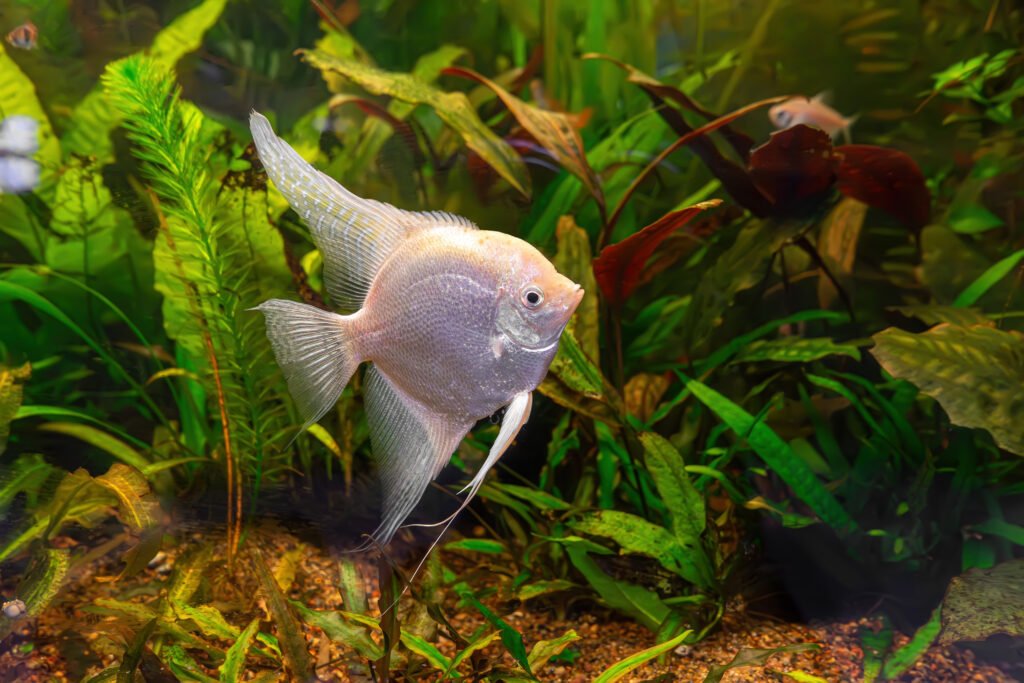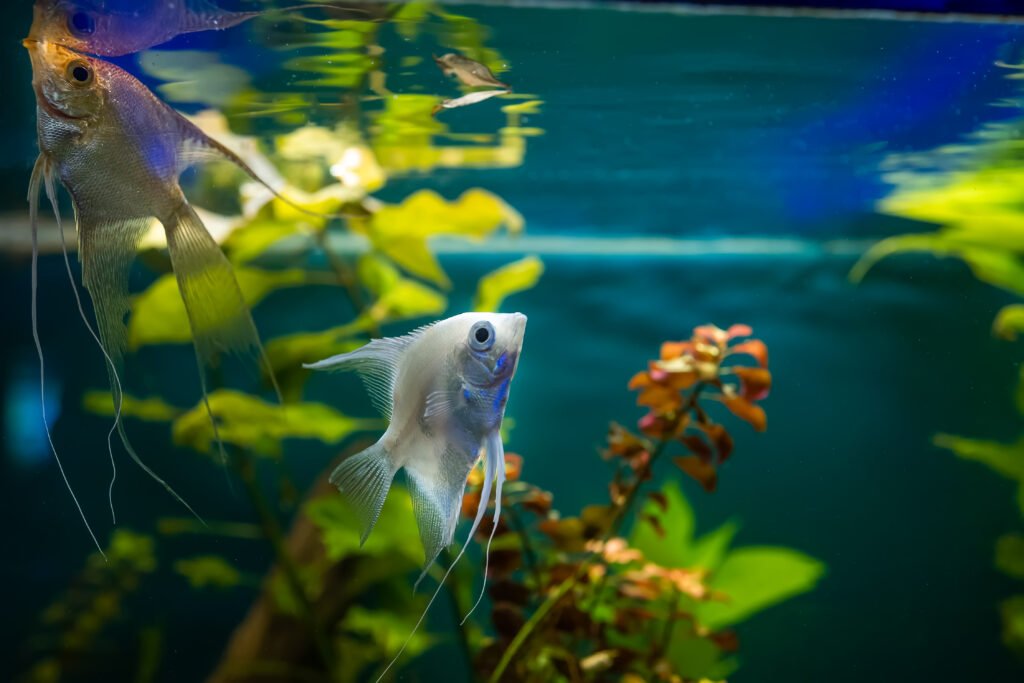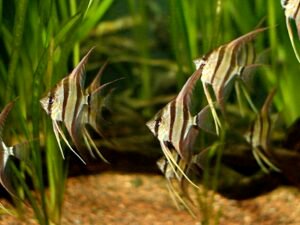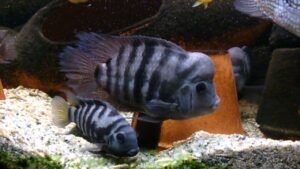The Graceful Beauties of the Aquarium
Keeping angelfish in the home aquarium can be a rewarding experience for both beginners and experienced hobbyists alike. With proper care and attention to their specific needs, angelfish can thrive and provide their keepers with years of enjoyment. Their peaceful nature and compatibility with a variety of tank mates make them a versatile addition to many community aquariums.
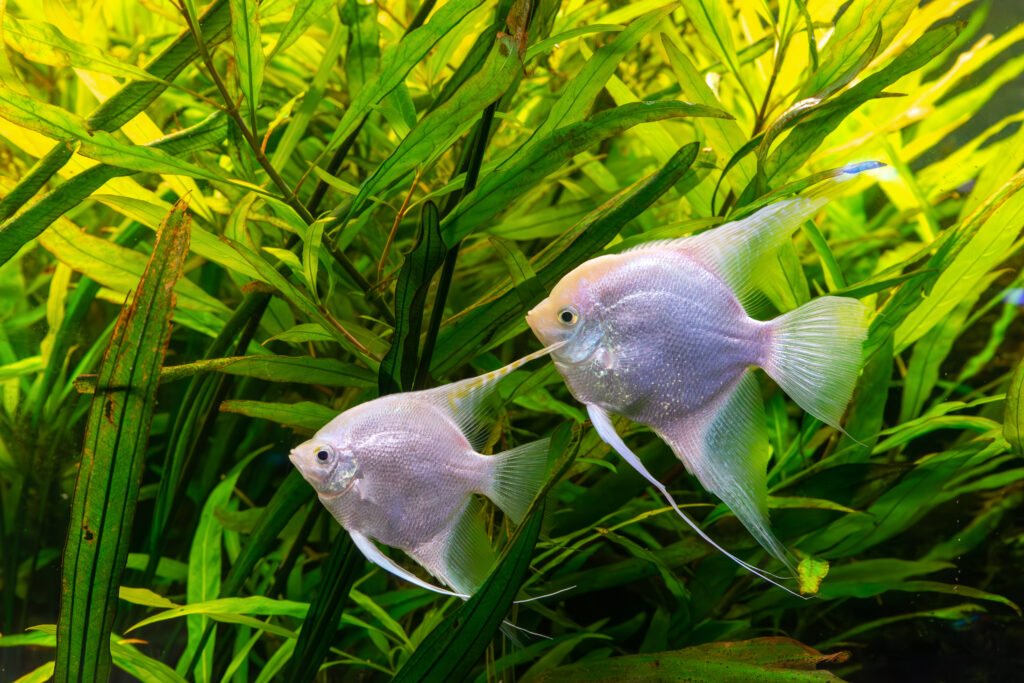
Tropical fish Pterophyllum scalare altum, angelfish swimming in aquarium water wtih green algae. Two white silver fishes in oceanarium pool. Aquatic organism, underwater life, aquarium pet
Angelfish: The Graceful Beauties of the Aquarium
Quick Facts
Scientific Name: Pterophyllum scalare
Year Described: 1823
Other Names: Freshwater Angelfish, Silver Angelfish
Kingdom: Animalia
Classification: Actinopterygii
Order: Cichliformes
Family: Cichlidae
Genus: Pterophyllum
Origins: Amazon River Basin in South America
Max Size: 6 inches (15 cm) in body length, 8-12 inches (20-30 cm) in height
Temperament: Generally peaceful, can be territorial
Aquarium Level: Middle to Top
Difficulty: Intermediate
Shoaling: No, but best kept in pairs or groups
Best Keep As: Pairs or groups in a spacious tank
Diet and Feeding: Omnivorous, requires a varied diet of quality flakes, pellets, and frozen foods
Reproduction: Egg layers, parents care for the eggs and fry
Average Lifespan: 10-12 years with proper care
Water Parameters:
Water Type: Freshwater
pH: 6.0-7.5
GH: 3-8 degrees of general hardness
KH: 3-8 degrees of carbonate hardness
Ideal Temperature: 75-82 degrees Fahrenheit (24-28 degrees Celsius)
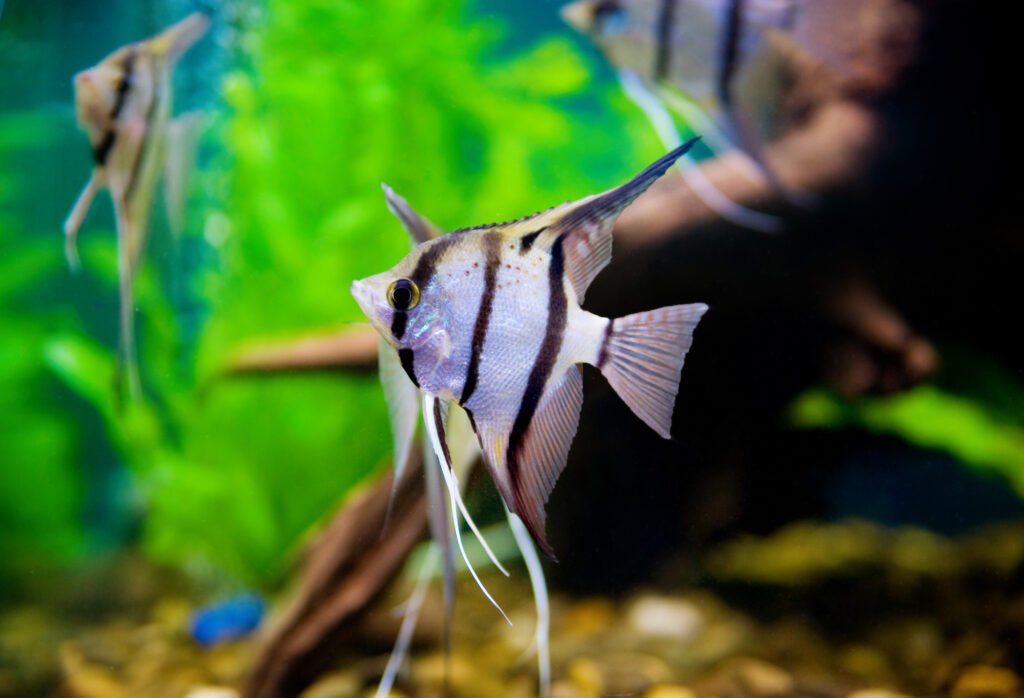
Introduction
Angelfish, with their elegant fins and graceful movements, are among the most popular and beloved freshwater aquarium fish. Native to the Amazon River basin in South America, these stunning cichlids have captivated the hearts of aquarists worldwide for generations. Their unique shape, vibrant colors, and captivating personalities make them a centerpiece in any aquarium.
Keeping angelfish in the home aquarium can be a rewarding experience for both beginners and experienced hobbyists alike. With proper care and attention to their specific needs, angelfish can thrive and provide their keepers with years of enjoyment. Their peaceful nature and compatibility with a variety of tank mates make them a versatile addition to many community aquariums.
In this comprehensive guide, we’ll explore the fascinating world of angelfish, covering their origins, varieties, care requirements, and breeding. Whether you’re considering adding these graceful beauties to your tank or simply want to learn more about these iconic fish, this guide will provide you with the knowledge and inspiration to create a stunning angelfish display.
Varieties
One of the most exciting aspects of keeping angelfish is the wide array of varieties available in the aquarium trade. Through selective breeding, a remarkable range of colors, patterns, and fin types have been developed, each with its own unique charm and appeal. Some popular angelfish varieties include:
- Silver Angelfish: The original wild-type angelfish, featuring a silver body with distinctive vertical black stripes.
- Gold Angelfish: A striking variety with a gold or yellow body color, often with reduced or absent black stripes.
- Koi Angelfish: Named after the popular ornamental koi carp, these angelfish display a marbled pattern of orange, black, and white.
- Marble Angelfish: Characterized by a mottled or marbled pattern of black and silver, creating a unique and eye-catching appearance.
- Black Lace Angelfish: A stunning variety with a black body and intricate, lace-like patterns on the fins.
- Zebra Angelfish: Featuring bold, vertical black and white stripes reminiscent of a zebra’s coat.
- Smokey Angelfish: A more subdued variety with a smokey gray or black coloration, often with hints of silver or white.
- Albino Angelfish: A rare and highly sought-after variety with a pure white body and pink or red eyes.
In addition to these color morphs, angelfish also come in different fin types, such as veil tail, super veil, and half-black. Each variety brings its own unique aesthetic to the aquarium, allowing keepers to create visually stunning and diverse angelfish communities.
Care Guide
To ensure the health and well-being of your angelfish, it’s crucial to provide them with a suitable environment and proper care. Here are the key aspects of angelfish care:
Tank Size and Setup:
Angelfish require a spacious tank to accommodate their size and swimming habits. A minimum tank size of 30 gallons is recommended for a pair of angelfish, with larger tanks being ideal for groups or community setups. Angelfish appreciate tall aquariums that provide ample vertical swimming space.
When setting up an angelfish tank, create a natural and visually appealing environment with a mix of live plants, driftwood, and rocks. Amazon sword plants, Vallisneria, and floating plants like water sprite provide excellent hiding spots and help maintain water quality. Avoid sharp or abrasive decor that could damage the angelfish’s delicate fins.
Water Parameters:
Maintaining stable and suitable water parameters is essential for the health and vitality of angelfish. As native to the Amazon River basin, angelfish prefer soft to moderately hard, slightly acidic water.
Temperature: Angelfish thrive in warm water, with an ideal temperature range of 75-82°F (24-28°C). Use a reliable aquarium heater to maintain a consistent temperature.
pH: The optimal pH range for angelfish is between 6.0 and 7.5. Regular testing and adjusting of pH levels may be necessary to ensure stability.
Hardness: Angelfish prefer soft to moderately hard water, with a general hardness (GH) of 3-8 degrees and a carbonate hardness (KH) of 3-8 degrees. If your tap water is too hard, consider using a reverse osmosis (RO) system or diluting it with distilled water.
Perform regular water changes of 10-20% per week to remove accumulated waste and maintain excellent water quality. Consistent maintenance and monitoring of water parameters are crucial for the long-term health of your angelfish.
Diet and Feeding:
Providing a balanced and nutritious diet is essential for the growth, coloration, and overall health of angelfish. In the wild, angelfish are omnivorous, feeding on a variety of small invertebrates, plant matter, and detritus.
In the aquarium, offer your angelfish a diverse diet consisting of high-quality flakes or pellets designed for cichlids as a staple food. Supplement this with regular offerings of frozen or live foods such as bloodworms, brine shrimp, and daphnia to provide additional protein and encourage natural foraging behavior.
Vegetables like blanched spinach, lettuce, or spirulina-based foods should also be included in the angelfish diet to provide essential vitamins and minerals. Offer vegetable matter a few times a week to ensure a well-rounded diet.
Feed your angelfish small portions 2-3 times a day, adjusting the amount based on their age, size, and appetite. Avoid overfeeding, as it can lead to obesity and water quality issues. Remove any uneaten food after a few minutes to maintain a clean and healthy aquarium.
Tank Mates:
Angelfish are generally peaceful fish that can coexist with a variety of tank mates. However, it’s essential to choose companions that are compatible in terms of size, temperament, and water requirements.
Some suitable tank mates for angelfish include:
- Peaceful tetras: Neon tetras, cardinal tetras, and rummy nose tetras make excellent companions for angelfish, adding color and activity to the tank.
- Corydoras catfish: These peaceful bottom-dwellers help keep the substrate clean and provide a sense of security for angelfish.
- Dwarf cichlids: Certain dwarf cichlid species, such as Apistogramma and Mikrogeophagus, can coexist harmoniously with angelfish in larger tanks.
- Gouramis: Peaceful gourami species, like pearl gouramis or moonlight gouramis, can be good tank mates for angelfish in spacious aquariums.
Avoid keeping angelfish with aggressive or fin-nipping fish, as well as small fish that could be perceived as prey. Careful research and consideration should be given when selecting tank mates to ensure a peaceful and stress-free environment for your angelfish.
Breeding
Breeding angelfish can be a fascinating and rewarding experience for dedicated aquarists. While it does require some preparation and attention to detail, the process of watching angelfish pair up, lay eggs, and care for their fry is truly captivating. Here’s what you need to know about angelfish breeding:
Pair Formation:
Angelfish are monogamous and form strong pair bonds. When breeding angelfish, it’s best to start with a group of young, healthy fish and allow them to naturally pair off. Signs of pair formation include swimming side by side, mutual grooming, and defending a shared territory.
Once a pair has formed, they should be moved to a dedicated breeding tank to minimize distractions and provide a controlled environment for spawning.
Breeding Tank Setup:
A breeding tank for angelfish should be at least 20 gallons in size, with soft, acidic water and parameters similar to the main angelfish tank. The tank should be dimly lit and include a flat, vertical surface for the angelfish to lay their eggs on, such as a breeding slate or a large, smooth leaf.
Filtration in the breeding tank should be gentle, with a sponge filter or a small canister filter, to avoid excessive water movement that may disturb the eggs or fry.
Spawning Process:
When angelfish are ready to spawn, the female will lay her eggs on the chosen surface, and the male will follow closely behind to fertilize them. Angelfish are substrate spawners and can lay hundreds of eggs in a single spawning event.
After spawning, the angelfish pair will diligently care for their eggs, fanning them to provide oxygen and removing any unfertilized or fungus-infected eggs. This parental care is crucial for the survival and development of the offspring.
Fry Care:
Once the eggs hatch, the angelfish fry will initially feed on their yolk sacs. After a few days, the fry will become free-swimming and require small, nutrient-dense foods such as newly hatched brine shrimp or commercial fry foods.
The angelfish parents will continue to protect and care for their fry, herding them into tight groups and defending them from potential threats. As the fry grow, they can be gradually transitioned to finely crushed flakes or small pellets.
Maintaining excellent water quality and providing frequent, small feedings are essential for the healthy development of angelfish fry. Regular water changes and monitoring of water parameters will help ensure the best possible growth and survival rates.
Challenges and Considerations:
Breeding angelfish can present some challenges, and it’s essential to be prepared and well-informed before attempting to breed these fish. Some common challenges include:
- Encouraging pair formation and spawning
- Maintaining optimal water quality in the breeding tank
- Providing appropriate nutrition for the fry
- Preventing fungal or bacterial infections in eggs and fry
- Managing aggression between breeding pairs or towards other tank mates
Research and preparation are key to successfully breeding angelfish. Joining online forums, local aquarium clubs, and seeking advice from experienced breeders can provide valuable insights and support throughout the breeding process.
Conclusion
Angelfish are truly remarkable and enchanting creatures that have captured the hearts of aquarium enthusiasts worldwide. With their graceful fins, vibrant colors, and captivating personalities, these freshwater gems bring a touch of elegance and beauty to any aquarium.
Successfully keeping and breeding angelfish requires dedication, knowledge, and a commitment to providing the best possible care for these stunning fish. By creating a well-maintained tank, offering a balanced diet, and selecting compatible tank mates, angelfish can thrive and bring immense joy and satisfaction to their keepers.
For those who are up for the challenge, breeding angelfish can be an incredibly rewarding experience. Witnessing the formation of a pair bond, the laying of eggs, and the diligent parental care provided by the angelfish is a true testament to the wonders of nature.
Whether you’re a seasoned aquarist or a newcomer to the hobby, angelfish make a fantastic addition to any freshwater aquarium. Their peaceful nature, adaptability, and stunning appearance make them a favorite among fish keepers of all levels.
As you embark on your angelfish journey, remember to continually educate yourself, connect with fellow enthusiasts, and prioritize the health and well-being of your aquatic companions. With patience, dedication, and a genuine appreciation for these remarkable fish, you can create a thriving and visually stunning angelfish aquarium that will bring you endless hours of enjoyment and fulfillment.
So here’s to the mesmerizing world of angelfish and the passionate community of aquarists who dedicate themselves to their care and admiration. May your angelfish bring you joy, tranquility, and a deeper connection to the incredible underwater world we share.
Happy fish keeping!
Views: 22

